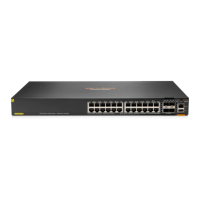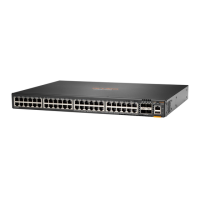245
Usage guidelines
The switch supports multiple hardware resource modes for the MAC address table, ARP/ND table,
and routing tables. The capacities of the MAC address table, ARP/ND table, and routing tables vary
by hardware resource mode. For table capacities in different scenarios, see Fundamentals
Configuration Guide.
This setting takes effect after a reboot. Before rebooting the switch, make sure you know the
possible impact on the network.
Examples
# Set the hardware resource mode to 1 for the MAC address table, ARP/ND table, and routing
tables.
<Sysname> system-view
[Sysname] hardware-resource switch-mode 1
Do you want to change the specified hardware resource working mode? [Y/N]:y
The hardware resource working mode is changed, please save the configuration and
reboot the system to make it effective.
Related commands
display hardware-resource switch-mode
hardware-resource routing-mode (Layer 3—IP Routing Command Reference)
header
Use header to configure a banner.
Use undo header to delete a banner.
Syntax
header { incoming | legal | login | motd | shell } text
undo header { incoming | legal | login | motd | shell }
Default
The device does not have banners.
Views
System view
Predefined user roles
network-admin
Parameters
incoming: Configures the banner to be displayed before a modem dial-in user accesses user view. If
authentication is required, the incoming banner appears after the authentication is passed.
legal: Configures the banner to be displayed before a user inputs the username and password to
access the CLI.
login: Configures the banner to be displayed before password or scheme authentication is
performed for a login user.
motd: Configures the greeting banner to be displayed before the legal banner appears.
shell: Configures the banner to be displayed before a non-modem dial-in user accesses user view.
text: Specifies the banner message. You can enter the banner message on the same line as the
keywords or on different lines. For more information, see Fundamentals Configuration Guide.

